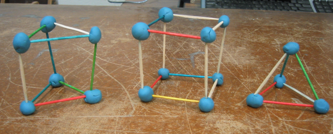Simple,
at home experiment:
To make some excellent and strong bubbles, here is a recipe (7):
 Figure 8. Examples of different 3-D bubble wands made out of toothpicks and modeling clay (7). From this simple experiment, one
can notice that the bubbles always take the
shape with the minimal surface area, a sphere
when in midair. With the 3-D wands, the bubble
will fill in the shape with the least area
inside the wand. The bubble is able to maintain
this shape because of surface tension.
Updated 11/23/2016
|